Prepare test files
checkout https://github.com/Taras-Tymchiy/ts-object-path
change the compile option target to es6. run build.
copy the generated js file, which we have already done.
JS explain
The JS part and TS part could be analysed seperately
Decomposition
As show in app.js file, an property accessor such as p.collection[0].nested.one can be decomposed into :
const get1 = p.collection;
const get2 = get1[0];
const get3 = get2.nested;
const get4 = get3.one;By inspecting each step, we know that every get<k> will return an Proxy object.
Step by step
The syntax aspect is recursive. First time we call createProxy(), we get a Proxy instance such that when this proxy object p in future gets key-accessed by an expression such as p.collection, it will recursively call createProxy() and then return another proxy instance. The crucial part is that we get a "side effect" by leveraging the closure created by createProxy(path) call. The side effect is actually to concatenate key with previous keys then "remember" the "path".
Note that all these are done before calling the next accessor [0]. So each prop accessor operation are not interlaced. This helps a lot with understanding the whole process.
The final proxy object is get4. get<k> is such an proxy object that when got accessed by an special key pathSymbol, it will return the path remembered and done.
Therefore, get4, when accessed by pathSymbol in the getPath call, finally returns the whole path [ "collection", 0, "nested", "one"].
TS explained
When called with type such as
interface IExample {
one: number;
two: string;
nested: IExample;
collection: IExample[];
}
createProxy<IExample>The return instance is of ts type
ObjPathProxy<IExample, T>which is
{
[P in keyof T]: ObjPathProxy<IExample, T[P]>;
}p.collection[0].nested.one
every time prop gets accessed, the return type's key is strongly typed, not the return type. This is enough for typing the path. For runtime, This is also ok because the runtime correctness is guaranteed by js but not ts.
for example,
p.collection will get type ObjPathProxy<IExample, collection>, which is an Array<IExample>, so that we can continue to access by [0]

